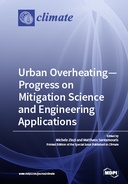Explore

Urban Overheating - Progress on Mitigation Science and Engineering Applications
Michele Zinzi and Matheos Santamouris
2019
0 Ungluers have
Faved this Work
Login to Fave
The combination of global warming and urban sprawl is the origin of the most hazardous climate change effect detected at urban level: Urban Heat Island, representing the urban overheating respect to the countryside surrounding the city. This book includes 18 papers representing the state of the art of detection, assessment mitigation and adaption to urban overheating. Advanced methods, strategies and technologies are here analyzed including relevant issues as: the role of urban materials and fabrics on urban climate and their potential mitigation, the impact of greenery and vegetation to reduce urban temperatures and improve the thermal comfort, the role the urban geometry in the air temperature rise, the use of satellite and ground data to assess and quantify the urban overheating and develop mitigation solutions, calculation methods and application to predict and assess mitigation scenarios. The outcomes of the book are thus relevant for a wide multidisciplinary audience, including: environmental scientists and engineers, architect and urban planners, policy makers and students.
This book is included in DOAB.
Why read this book? Have your say.
You must be logged in to comment.
Rights Information
Are you the author or publisher of this work? If so, you can claim it as yours by registering as an Unglue.it rights holder.Downloads
This work has been downloaded 569 times via unglue.it ebook links.
- 146 - pdf (CC BY-NC-ND) at Unglue.it.
Keywords
- ageing
- air and surface temperature measurements
- Air quality
- air temperature
- albedo
- Beirut
- building energy performance
- building retrofit
- building scale
- built-up area
- calculation
- climatic perception
- cool facades
- cool materials
- cool pavements
- cool roofs
- cool surfaces
- cooling technologies
- cost-optimal analysis
- Earth sciences
- emissivity
- EMPIR 16NRM02
- empirical line method
- energy savings
- energy simulation
- ENVI-met
- Euramet
- fine-resolution meteorological modeling
- genetic algorithm
- GIS
- green area
- heat health
- heat stress
- land cover fraction
- Land surface temperature
- lifecycle analysis
- local climate zone
- luminance coefficient
- material characterization
- Measurement
- meteorological modeling
- Meteorology & climatology
- micro-climate simulations
- mitigation measures
- mitigation strategies
- mobile temperature observations
- MODIS downscaling
- morphological indicator
- multi-objective optimization
- multifractal analysis
- multiple linear regression
- non-constructible parcels
- Office buildings
- Open science
- outdoor thermal comfort
- overheating
- park cool island
- Physiologically Equivalent Temperature
- road lighting
- road surface
- shading
- sky view factor
- solar reflectance
- solar reflectance index
- spectral analysis
- spectral reflectance
- structure functions analysis
- subtropical climate
- summer heat stress
- surface albedo
- surface cool island effect
- sustainability
- thermal comfort
- thermal emittance
- Urban Areas
- urban climate
- urban climate archipelago
- Urban climatology
- urban cooling
- Urban development
- urban energy balance
- urban heat island
- urban heat island index
- urban heat mitigation
- urban microclimate
- urban morphology
- urban open space
- urban overheating
- urban remote sensing
- urban vegetation
- urban-climate archipelago
- Urbanization
- urbanized WRF
- Weather Research and Forecasting model
- Weather Research and Forecasting model (WRF)
- WRF-Chem
- “cold spots”
- “hot spots”
Links
DOI: 10.3390/books978-3-03897-637-0Editions

